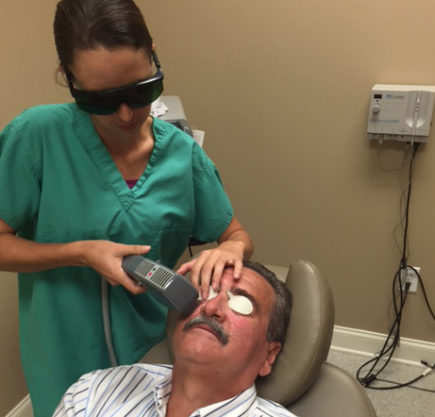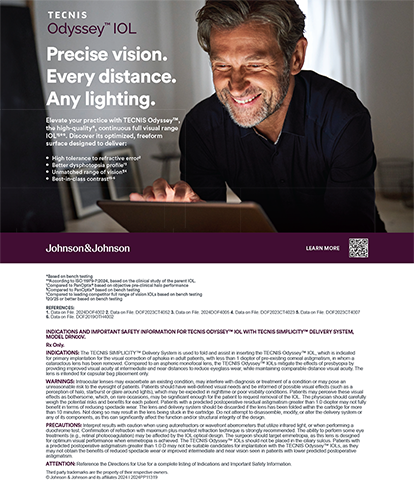
Dry eye disease (DED) is one of the most common disorders I see in my practice, and it can significantly affect cataract surgery outcomes. DED not only leaves patients feeling uncomfortable, but it also hinders surgeons’ ability to obtain accurate preoperative measurements and negatively affects postoperative quality of vision. Aggressively optimizing the ocular surface, both pre- and postoperatively, makes a huge difference in terms of clinical outcomes.
DIAGNOSTIC PROTOCOL
My practice has instituted a specific protocol for identifying DED. Every cataract surgery patient completes an Ocular Surface Disease Index questionnaire and gets a tear osmolarity score when he or she walks in the door. If the TearLab Osmolarity System (TearLab) detects an osmolarity score of 315 mOsm or higher, no preoperative workup is done until I examine the patient; I have found that this approach prevents a lot of cataract surgery workups from having to be thrown out once DED is treated. If a patient’s condition is not optimal for obtaining refractive measurements and undergoing surgery, we aggressively treat the DED first.
TREATMENT PROTOCOL
With our focus on the meibomian glands and their contribution to this condition, we strive to educate patients about why they have DED. We are big believers in strategies that aim to make the meibomian glands work better, in addition to treating any aqueous tear deficiency. Younger patients with mild DED, no significantly elevated tear osmolarity, and no detection of MMP-9 (InflammaDry; RPS) are typically started on artificial tears and warm compresses. We will continue conservative therapy as long as patients are showing improvement. Nutritional supplements are also helpful, but we have found that compliance wanes over time, because the capsules are generally taken four times daily, which many patients find inconvenient.
Watch It Now
In this episode of Ophthalmology Insider, Preeya Gupta, MD, and Brandon Ayres, MD, sit down with moderator Mark Kontos, MD, to discuss the challenges associated with dry eye disease and new technologies that allow surgeons to better care for their patients.
Lisa Feulner, MD, PhD, explores radiofrequency treatments for dry eye disease in this episode of CRST Journal Club.

LISTEN UP
In this installment of the podcast Ophthalmology off the Grid, Whitney Hauser, OD, and moderator Gary Wörtz, MD, address some unanswered questions about dry eye disease. Click the microphone to listen now.
If the patient has meibomian gland dysfunction or a poor response to artificial tears, our next step is Restasis (cyclosporine ophthalmic emulsion 0.05%; Allergan). Although Restasis is effective on its own, we have found that, when used in conjunction with a lid hygiene routine (Avenova; Nova Bay), it works better, faster, and more effectively. The mechanical wiping of the lids and the Neutrox in Avenova help remove bacteria that clog the meibomian glands, while Restasis combats the inflammatory component of DED. This pairing has been one of our secrets to success with patients who have moderate to severe DED. Our current regimen pairs twice-daily Restasis with once-daily Avenova.
For patients with severe DED, the next step in our regimen is intense pulsed light (IPL) therapy via the Toyos technique.1 IPL is an intense flash of light with heat that coagulates the telangiectatic vessels at the eyelid margins that are common with meibomian gland dysfunction (Figure). Treatment has a direct thermal effect on the meibomian glands that, in effect, melts the gummed-up secretions to help unclog the glands. IPL tends to work best in patients who have ocular rosacea, and they report tremendous symptomatic relief. That said, we will administer this therapy to any patient who does not respond to other treatments. IPL is generally performed once a month for 4 months, and then maintenance treatments are done as needed, typically once a year. Patients continue their Avenova usage to maintain lid hygiene. (For more on IPL, see Dr. Adler’s article)

Figure. A patient undergoes IPL at Metrolina Eye Associates.
CONCLUSION
As a premium lens surgeon, I have found that the number-one factor contributing to my success and to my patients’ satisfaction is my attention to DED. Instead of feeling irritated by a delay in their cataract surgery, most of our patients are impressed by our attention to detail and quest for perfection. When it comes to DED, education, aggressive preoperative treatment, and appropriate postoperative management are key for premium lens patients.
1. Toyos R, McGill W, Briscoe D. Intense pulsed light treatment for dry eye disease due to meibomian gland dysfunction; a 3-year retrospective study. Photomed Laser Surg. 2015;33(1):41-46.




